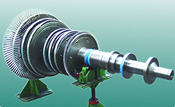OUR LOCATIONS
We can provide our services to power plants worldwide
Bradenton, Florida
941 - 527 - 6196
941 - 755 - 5229 (FAX)
Milwaukee, Wisconsin
414 - 698 - 5644
|

ROTOR BALANCING
Z-R Consulting’s unique advantage in rotor balancing is in applying our proprietary Quasi-high Speed Balancing Method (or 2N+1 Method). This balancing method is designed for and works on any bowed or eccentric rotors, and provides a substantially cheaper and faster means of getting such rotors back into operation. With this balancing approach, even the most challenging rotors can be successfully balanced in only 10-20 runs, with most cases completed in fewer runs than that. It also provides a guarantee that the balanced rotor will run smoothly once reinstalled in the field.
Please click on the links to the left to explore our rotor balancing background and approach in much more detail.
The topic of rotor balancing can be divided in a few ways. First, balancing can be performed on individual rotors in a service shop, utilizing either a high-speed balancing facility or a low-speed machine. When balancing individual rotors, one must consider a rotor’s level of flexibility or rigidity, and especially must consider the presence of distributed mass eccentricity, rotor bows, or local unbalances, each of which creates separate and unique dynamic effects, requiring separate consideration within a specific, appropriate balancing approach.
Rotor balancing can also be performed in the field on assembled multi-rotor machines (however, this contains some caveats). All vibration observed on a rotor train in a plant can be a combination of individual rotor flaws (eccentricity, bows, and unbalance) and rotor train misalignment. Field balancing cannot properly resolve vibration from misalignment, and with limited access to balance planes, field balancing cannot fully compensate bows or eccentricities. In certain cases, field balancing can “save the day” temporarily and extend operation time until an available time for a planned outage and proper repair, but can be risky to consider as a complete or long-term solution.
The most important element of rotor balancing is in knowing when it is an appropriate solution to high vibration, and if so, which balancing approach to take depending on the specific circumstances of each case.
|